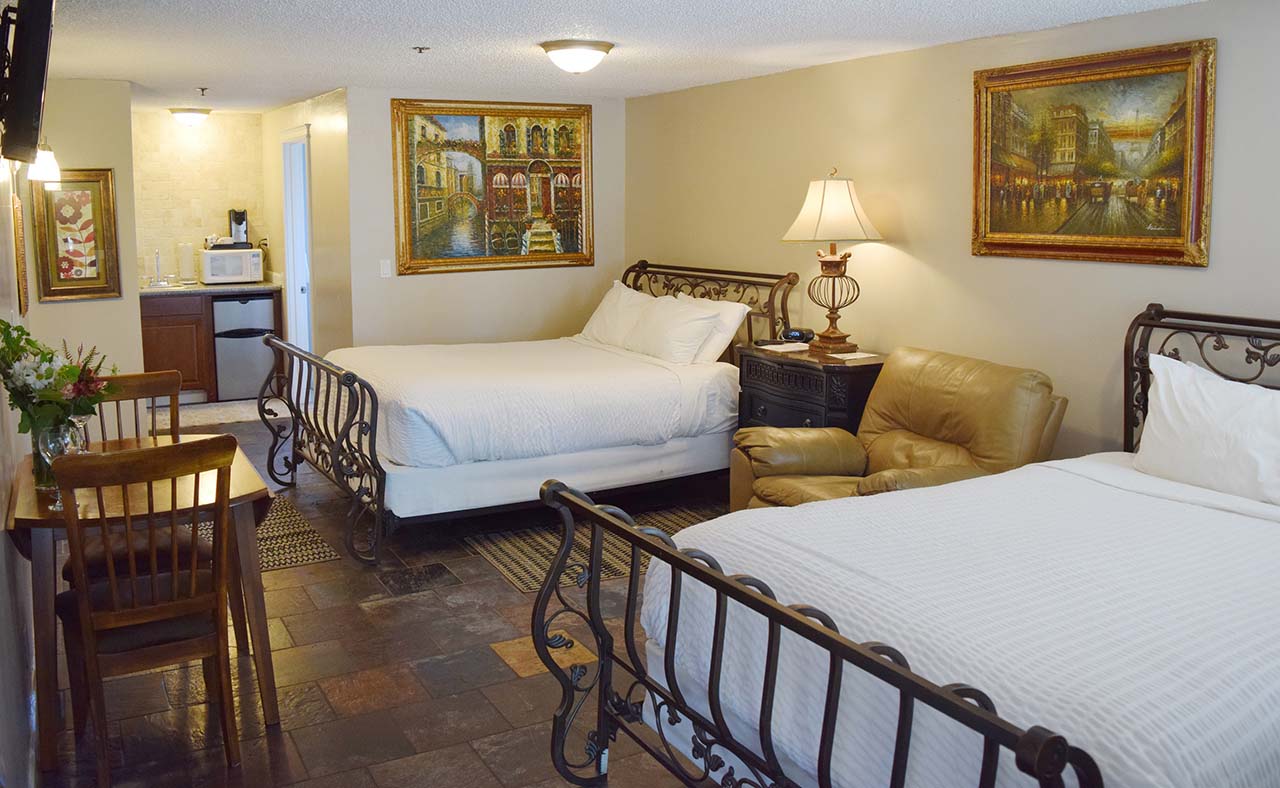
The Pioneering Doctors Room
Search Rooms
The year 1948 saw Dr. Joseph M. Blackerby, a Virginia native, open the area’s first medical practice. He was followed in 1851 by Dr. Albert G. Hutton and Dr. Benjamin Davenport, the grandfather of Homer Davenport, and in 1852 by Dr. Platt A. Davis. These four pioneer physicians were to provide medical coverage for the Silverton Country for many years.
The earliest known public interest in a hospital for Silverton was recorded in the Silvertonian Appeal on April 1, 1910. Under a banner, “Scandinavian People Will Erect Institution Which Will Be a Credit to all Oregon,” the article reported a proposition by members of the “Scandinavian Lutheran churches” to build a non-denominational hospital to serve the community.
Room Amenities
- Two Queen Beds
- Pet Friendly
- Kitchenette
- Bathroom With Shower / Jetted Tub
- Smart TV
- Wi-Fi Internet
- Heat / Air Conditioner
- Alarm Clock / Radio
- Coffee Maker
- Hair Dryer
- Iron & Ironing Boards Available
The “Keene” Hospital: The enthusiasm of 1910 had apparently waned by 1914, and little is known today about the reasons why the 1910 project did not come to fruition.
The Silver Falls Timber Company had need of a physician and a medical facility to provide for its ever-growing cadre of loggers and mill workers. Accidents in the woods were frequent, quick and spectacular, sometimes posing a greater challenge for the mortician than for the physician. In 1914, the Silver Falls Timber Company and the earlier Silverton Lumber Company jointly contracted with Clarence W. Keene, M.D., who in 1911 at age 36 had opened his Silverton office to become the “mill doctor.” Affectionately referred to as “Old Pills and Iodine” by the mill workers, Dr. Keene was enthusiastic about the prospect of providing medical services for the employees, but concerned over the lack of a local hospital facility.
Dr. Keene therefore set about locating a suitable facility, and finally purchased a large, two story house on East Hill to serve the dual function of mill hospital and family home. A Silverton Appeal article suggested that the purchase occurred sometime in 1914, but Pat and Dennis Rowden report that the deed was recorded in 1915.
Dr. Keene provided inpatient care, and fitted out an operating room on the top floor to take best advantage of natural daylight. Although intended for Dr. Keene’s mill and private patients, Dr. Keene graciously made the facility available to any doctor who needed to use it.
The old Keene hospital is one of the most prominent features on East Hill. Although all Silverton residents have seen this building, few realize that it was Silverton’s first actual hospital. Because of the location on a steep hill made access difficult in ice and snow, Dr. Keene strongly supported the acquisition of a facility to serve as a proper hospital for the community. The Keene building was sold in 1920 to C.J. “Chris” Rosheim, a veteran of the “Great War,” who converted it into a boarding house.
The North Water Street Hospital: Dr. Keene and other prominent leaders including P.A. Loar, C.E. Ross, Rev. George Hendricksen, H.B. Latham, J.H. Porter, N. Digerness, George Steelhammer, Julius Alm, P.L. Brown and J.E. Callister created the Silverton Hospital Association, a stock company.
After considering several alternatives, the company purchased the property at 1103 North Water Street for the hospital. It was remodeled to convert the building to a hospital in less than two months. An article in the Silverton Appeal in 1918 described the hospital as being on spacious grounds with good fittings, operating room and fifteen beds.
Loretta Mae Day was appointed Chief Nurse with Jo Daugherty as Hospital Superintendent. The first patient was L. Stickler, on December 8, 1918; the admitting doctor was Dr. Keene, and the nurse assigned was Miss Girod. He was discharged three days later, cured of whatever had ailed him.
Practically every patient admitted to the hospital could expect at least one soap suds enema, a tried and true remedy of the day. Enemas came in an almost infinite variety. There were saline enemas, glycerin enemas, olive oil enemas, milk and molasses enemas, soda bicarb enemas, coffee enemas, soda and sugar enemas, to name but a few.
Other interesting remedies of the day included turpentine compresses, lysol douches, chloroform liniment, whiskey, hot camphorated oil, and the old standby, chicken broth. An article in the Silverton Appeal Tribune was said to have reported that the prevailing treatment for pneumonia during the 1920s was a chest rub with camphorated oil, then covered with a cotton batting and gauze chest pad to assure that the oil’s penetrating, counterirritant effect worked to its fullest.
In 1926, A Silverton Appeal article reported a certain Gerome Morley had left his entire estate, valued at $23,000, to Silverton Hospital, thereby disinheriting his many relatives. Gerome was anxious to provide a legacy with would benefit the entire Silverton community. His Will directed that one room would always be available for his friends and family, and when not being used by them be available for worthy, needy or destitute persons. The Will was contested by Morley’s relatives, but was eventually settled out of court in 1932, with the hospital receiving all but $1500 for attorney’s fees. The free Morley room was credited with helping many people. Morley’s grand niece reflected on how Gerome’s Will may have saved her brother’s life. She mused, “So may God bless Gerome Morley.”
The West Hill Hospital: Hospital board secretary George Hendricksen lamented that patients had to be sent elsewhere due to overcrowding and x-ray work beyond the portable machine at the hospital, and that the laboratory was not big enough for more advanced equipment that was becoming available. Dr. Loar was a key figure in the drive to establish the Water Street hospital, who in 1931 pushed for the City to take over the hospital and issue bonds to build a more modern hospital. The Silverton Appeal-Tribune was reporting with disturbing frequency that patients had gone to Salem or Portland for hospitalization.
It was the sudden death of Rebecca Stevens Mount in 1936 that provided the means for Silverton to have a modern facility designed and built on her property on West Hill with commanding views of the Willamette Valley and the Coast Range. Rebecca’s son, Guy Mount, M.D. decided that the property should be used as a hospital. The family home would serve as an excellent nurses’ living facility. The gift of Gerome Morley several years earlier provided the seed money to plan and build the new hospital.
The property was deeded to the hospital in 1936, with a condition that the Hospital Association would dedicate a grove on the premises as an H.D. and Rebecca Mount Memorial Park. The new hospital would have modern surgical facilities and space for 25 beds and would be a memorial to Gerome Morley. Board members at the time included George Steelhammer, G.W. Hubbs, E.S. Porter, M.G. Gunderson and A.W. Simmons. The new single story brick hospital was dedicated in April 1937, with Oregon Governor Charles H. Martin as the keynote speaker and a host of regional dignitaries, with nearly 2,000 people in attendance.
For more information, please visit the Silverton Country Historical Society Museum at 428 South Water Street in Silverton, Oregon. Website: www.silvertonmuseum.com

